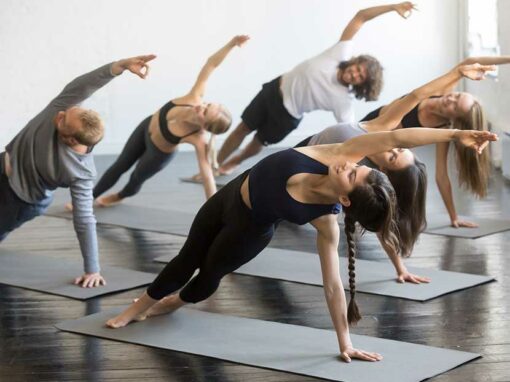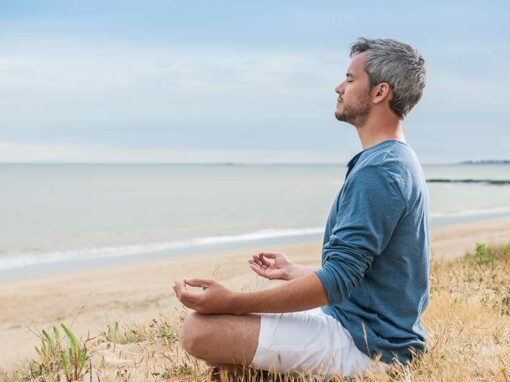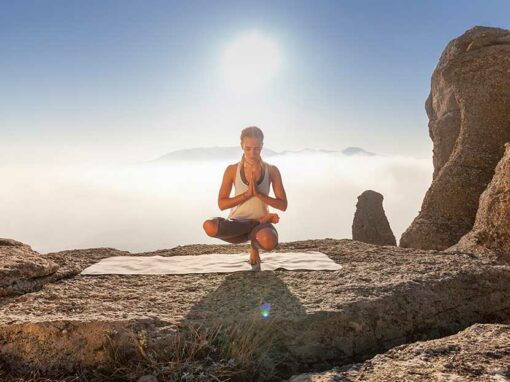How Does Yoga Help To Have A Good Night Sleep
– Guest blog post by Marianna –
Benefits Of Yoga
Yoga is known for giving us many benefits, and one of them is helping to wind down our days.
Most people practice Yoga for wellness and they feel motivated to exercise more regularly, to eat healthier. They reported improved sleep and reduced stress levels.
Our Lifestyle
Our bedtime routine has been certainly changed in the past 20 years.
Scrolling the phone to check the last email, triggered by the notification sound from our socials, binge-watching the last popular Netflix series, are all factors that affect our ability to get a good night’s sleep.
The stress response is continuously stimulated and with it the sympathetic nerve system. The heart rate is accelerated, the muscle tension is increased, and the pupils are dilatated.
We are sending messages to our body that it needs to be awake and respond fast.
All this accumulated tension doesn’t help to get it ready to rest. We might suffer from insomnia, anxiety, tachycardia.


If the reasons behind these diseases are related to our lifestyle, a digital detox before bed and a 30 minutes yoga restorative routine can be very beneficial to wind our body down ready for sleep.
There’s no single style or sequence of yoga that’s ideal for everyone at night. It’s more to focus on steady and slow breathing and practice gentle movements and stretches.
Go Slow To Go Far
A simple equation of easy movements and slow breathing can instigate your parasympathetic nervous system, providing you with release and relaxation.
3 Breathing Techniques For A Good Night’s Sleep
1. We often breathe rapidly and into our chest when we are stressed and we need more oxygen. Breathing with long full, deep inhalations and exhalations, and into the belly calms our mind.
2. Chandra Bhedana Pranayama (Moon-Piercing Breath)is a single-nostril breath associated with cooling, calming energy.
Choose a comfortable sitting position, press the index and middle finger of your hand towards the palm. Use the right thumb to shut the right nostril. If you are left-handed, do it with the opposite hand.
Inhale slowly and deeply through your left nostril until your lungs fill with maximum air.
Hold your breath for some time or as per your capacity. Breathe out (exhale) slowly through the right nostril. Exhalation should be longer than inhalation.
Repeat about 10 times.
3. Ujjayi breath is mostly known as the breath to warm us up during our practice, but his gentle and calming sound can also help to relax.
Inhale deeply through the nose. With your mouth closed, exhale through your nose while constricting the back of your throat as if you are saying “ha” but keep your mouth closed. This exhalation should sound like the waves of the ocean.
Use this slow and steady breath to soothe yourself just by sitting in a comfortable position or in each of these poses I will describe below.


5 Yoga Asanas To Help You Get Better Sleep
1. Viparita Karani (Legs-up-the-wall)
Sit close to the wall, with one hip touching it, and bring your hands slightly behind your hips.
Bend your elbows and slowly lean back as you simultaneously lower your back to the floor and sweep your legs up the wall. Bring your buttocks as close to the wall as possible.
Let your legs relax into the wall, keeping a slight bend in your knees if your hamstrings are tight. Rest with your arms by your sides or in cactus arms, palms up.
2. Ananda Balasana (Happy Baby Pose)
Bring your knees into your chest and grab the outside of the sides of your feet.
Extend your legs a little and bring your knees wide, letting your elbows fall inside your thighs.
Push into your hands, feeling a nice stretch.
You can gently roll from side to side or forward and backward to give your lower back a little massage.
3. Baddha Konasana (Butterfly Pose – Yin Version)
Bring the soles of your feet together in front of you, being mindful of your knees.
Your feet can be as near or as far away from your pelvis as feels good, and you may need to sit on a pillow to elevate your hips or support your knees on either side with pillows.
Inhale and stretch your spine upwards, then gently start to fold forwards, curving your spine and neck to bring your forehead towards your feet.
Stop wherever it feels as though you have found a good stretch, and stay for 10-15 breaths, breathing into your back.
4. Utthan Pristhasana (Lizard Pose)
From Adho Mukha Svanasana (Downward-Facing Dog Pose), bring your left foot forward between your hands and lower your right knee to the floor.
Walk your left foot to the outer edge of your mat and place your elbows or forearms on a block or the floor. Remain for 10–15 breaths. Repeat on the second side.


5. Supported Balasana (Supported Child’s Pose)
To end the sequence, take a pillow or a bolster and sit on one end, with your thighs on either side and your sit bones against your heels.
Gently fold forward to come to rest on the pillow, with your head turned to one side, keeping your sit bones and heels together if possible. If not, pop a blanket or pillow between them.
Relax into the pillow, letting it hold your weight, and try to let go of any thoughts that are still bouncing around in your mind.
This position gives a soothing effect to the central nervous system. It feels like a big hug.
Marianna has been practicing Yoga for more than eight years, and in 2020
she completed the 200h Yoga Teacher Training in Vinyasa at YogaMoves in Utrecht.
She is passionate about sharing Yoga with others, living more sustainably,
and traveling. Here is her INSTAGRAM page.




